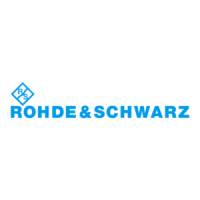Getting Started
R&S
®
ZNA
44User Manual 1178.6462.02 ─ 20
3.2.1.4 Front panel connectors
The test ports and three USB connectors are located on the front panel of the
R&S ZNA.
Test ports
Numbered connectors:
●
3.5 mm male for R&S ZNA26
●
2.92 mm (K) or 2.4 mm male for R&S ZNA43
●
2.4 mm male for R&S ZNA50
●
1.85 mm male for R&S ZNA67
The test ports serve as outputs for the RF stimulus signal and as inputs for the mea-
sured RF signals from the DUT (response signals).
●
With a single test port, it is possible to generate a stimulus signal and measure the
response signal in reflection. For a measurement example, refer to Chapter 3.4.2,
"Reflection S-parameter measurement", on page 82.
●
With more than one test port, it is possible to perform full two-port, 3-port, ... , or n-
port measurements; see Chapter 4.3.1, "S-parameters", on page 122.
●
Use a torque wrench when screwing RF cables on the test port connectors.
●
See also Chapter 3.1.5, "Considerations for test setup", on page 31.
Connector usage
Two LEDs above each test port indicate the connector usage:
●
Tx on: connector is used as a source port
●
Rx on: connector is used as a receive port
●
both LEDs on: connector is used as a bidirectional (source and receive) port
Direct generator and receiver access
Hardware options R&S ZNA<frequency>-B16 "Direct Generator/Receiver Access",
provide 3 pairs of SMA connectors for each test port, where <frequency> corresponds
to the network analyzer type. For detailed ordering information, refer to the product
brochure.
See also the section on Converter Control.
These connectors give direct access to the RF input and output signal paths.
●
The Source Out signal comes from the internal RF signal source. The Source In
signal goes to the test port. A power amplifier can be inserted between Source Out
and Source In to boost the test port power.
●
The Ref Out signal comes from the coupler and provides the reference signal. The
Ref In signal goes to the receiver input for the reference signal.
●
The Meas Out signal comes from the coupler and provides the received signal (to
be measured). The Meas In signal goes to the receiver input for the measured sig-
nal.
Instrument tour

